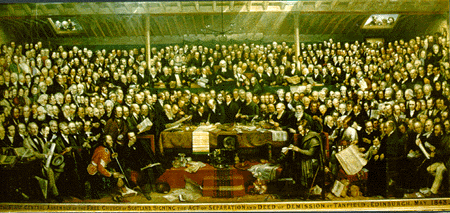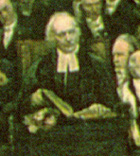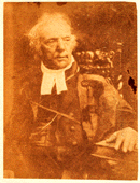The Disruption Picture
The painting of The First General Assembly of the Free Church of Scotland signing the Act of Separation and Deed of Demission on 23rd May 1843 by David Octavius Hill is internationally important as being the first work of art painted with the help of photographic images. The painting is a commemorative image of the Assembly; Hill depicted 457 people associated with it from a total of 1500 present, 386 of whom signed the Act that day. The painting measures 4' 8" x 12', and took Hill 23 years to complete. It has hung in the Free Presbytery Hall, The Mound, Edinburgh, since 1866.
The Act of Separation and Deed of Demission was the culmination of events where 474 ministers of the Church of Scotland voluntarily gave up their homes and their livings rather than surrender the spiritual independence of their Church. The ministers who had signed it were deemed no longer ministers of the establishment, or entitled to receive a Presentation. They were not, however, deposed. Hill was qualified for the self imposed task of depicting the Disruption; being a serious minded Free Churchman, having lived through the Ten Years' Conflict, and having been an eyewitness of the signing of The Act of Separation and Deed of Demission.

The First General Assembly of the Free Church of Scotland; signing the Act of Separation and Deed of Demission - 23rd May 1843 (D.O. Hill RSA).
Image © Free Church of Scotland, Photograph by George T. Thompson LRPS.
See Larger Image
Many of the photographs in the University of Glasgow Collection are associated with this project. Hill took reference from both single and group portraits for the picture, and although the painting predominantly features the ministers involved in the Disruption, Hill also includes many women who co-operated in the building up of the Free Church. On the right is an illustration of how he used the photographic portraits within the picture.
Go to next section: Relationship of the University of Glasgow's collection to that of the Scottish National Portrait Gallery (SNPG)
Quick Links
- Hill & Adamson Search
- More material on Photography
- Special Collections A-Z
- Search for rare books
- Search for manuscripts
- Order copies/images


- Rev Dr Thomas Chalmers. The central figure in the Disruption picture, Chalmers was the Moderator of the Disruption Assembly. His portrait in the Disruption picture (top) was taken directly from the salt print (below: HA0052 in the University Collection)

